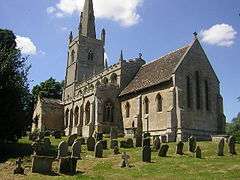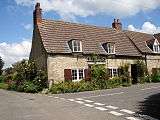Heydour
| Heydour | |
 St Michael's parish church, Heydour |
|
 Heydour |
|
| Population | 286 (2001 Census)[1] |
|---|---|
| OS grid reference | TF009395 |
| – London | 100 mi (160 km) S |
| District | South Kesteven |
| Shire county | Lincolnshire |
| Region | East Midlands |
| Country | England |
| Sovereign state | United Kingdom |
| Post town | Grantham |
| Postcode district | NG32 |
| Police | Lincolnshire |
| Fire | Lincolnshire |
| Ambulance | East Midlands |
| EU Parliament | East Midlands |
| UK Parliament | Grantham and Stamford |
|
|
Coordinates: 52°56′38″N 0°29′56″W / 52.944°N 0.499°W
Heydour is a hamlet and civil parish in the South Kesteven district of Lincolnshire, England.[2] The population of the civil parish was 286 at the 2001 census and increased to 311 at the 2011 census.[3] Heydour lies about 5 miles (8 km) south-west of Sleaford and 6 miles (10 km) north-east of Grantham. It forms a close group of parish hamlets with Kelby, Culverthorpe, Oasby and Aisby.
History
The Domesday Book records the place as "Haidure" and "Heidure", with 80 acres (32 ha) of meadow and 16 acres (6.5 ha) of woodland within the manor of Osbournby.[4] Before the Norman Conquest it was under the Lord of the manor lordship of Aelfric, son of Godram,[5] and after 1086, Vitalis.[6]
Around the village, particularly to the south, are earthwork indications of houses, crofts, quarries and ridge and furrow field systems from an earlier Medieval village.[7] The village belonged to the historical wapentake of Winnibriggs and Threo.[8]
In 1885 the area of the township was 3,140 acres (12.7 km2) with a population in 1881 of 363, and the parish, including Kelby and Culverthorpe, 5,140 acres (20.8 km2) with a population of 447. There existed in Heydour, since the 14th century, freestone quarries that provided the first stones for Belton House.[9][10][11]
Kelly’s stated: "In a field west of the church are traces of a large mansion or castle, supposed to have been built in reign of Stephen by one of the Bussey family, who were seated here until about 1609".[9] The Busseys were major landowners of the area and a branch of the same family at Hougham. When the son of John Bussey (ab.1533-1593), Sir Edmund Bussey (1562-1616), came in possession of what was then a manor house it was in a dilapidated state requiring rebuilding, and its land reorganising.[12] The castle or manor house was tightly, socially and physically, integrated with the manor and settlement of Heydour and its parish, unlike other areas of Lincolnshire.[13] The existence of the castle is indicated by remnants of masonry, foundations and ditch,[14] and is a listed monument.[15]
The village had its own school which was closed in 1983.[16]
Community
The hamlet of Oasby has been classified as a conservation area and dwellings in Heydour parish have been listed by the local authority as "of interest".[17][18]
The parish hamlets cooperate in events and functions.[17] There is an annual art exhibition, fete and scarecrow competition, and a group of Mummers, musicians and Morris dancers. An annual pantomime is held in the village hall in Aisby, and the parish church holds a carol concert on the Sunday before Christmas.[2] The Houblon Arms at Oasby is the local public house and restaurant. The nearest post office with a shop is in Wilsford, about 2 miles (3 km) north.
Landmarks
Church
Heydour Grade I listed Anglican parish church, is dedicated to St Michael. The church originates from the 12th century, with additions up to the 19th.[19] There is a 12th-century canonical sundial on the south wall. The church has an Early English chancel with lancet windows and a 17th-century north funerary chapel, and a nave with Perpendicular clerestory including six tracery panelled windows. It has Decorated north and south aisles with evidence at the roof line of earlier aisles, four arcades, a south porch, and a Decorated west tower with pinnacles, crenellations, and a Perpendicular recessed spire.
The church was probably the gift of Geoffrey de Saxe, prebendary of Heydour from 1325 to 1380. The chancel holds a tomb to the founder, and a sedilia.[14][20] The post-1342 roof above the north aisle was built from donations from Lord Scrope of Masham (1312-1391).[21]

A main feature of St Michael's is stained glass in the north aisle dating from about 1380. One window shows the figures of Edward the Confessor, St George and St Edmund. This was erected from donations from deacon Geoffrey Scrope and Beatrice Luttrell.[22] Another window depicts St Vincent, St Laurence and St Stephen. A third is from the 19th century and by William Wailes. Pevsner notes windows from 1899 by Kempe in the east, north and south chancel.[9][14][20] Further features are a priest's doorway with cinque-cusped head, octagonal font, a chest from 1530 to 1550, an ornamental painting in the chancel, and chalice and flagon by George Wickes from 1727.[14]
There are internal church monuments to the Newton family of Culverthorpe Hall, including Abigail Newton, died 1686. Others are to Sir John Newton, died 1734, and Margaret, Countess of Coningsby (Sir Michaels daughter-in-law), died 1761, both attributed to Rysbrack, and Lady Newton, died 1737, and Sir Michael Newton, died 1746, both by Scheemakers.[14] There is also a marble slab to the last male Newton heir, died 14 Jan 1723, the infant son of Sir Michael Newton and Margaret, Countess of Coningsby, who was stolen from his cradle in the absence of his nurse by a pet monkey that was pursued to roof of Culverthorpe Hall where it dropped the child over a parapet; he was killed by the fall.[9][23] The church bells commemorate with signatures Sir Edmund Bussey and his son Miles Bussey (born 1590 or 1592) and the arms of Sir Edmund and his wife Francis.[24]
Other parish listed buildings

- The Houblon Arms, Main Street, Oasby – a public house dating from the 17th century[25]
- Church Lees Farmhouse – c. 1700 with 1800 additions, possible a former rectory, now a classical farmhouse[26] with a niche above the front door in which is set a 14th-century stone figure of a young musician with cymbals, said to be from the castle which stood west of the house.[14]
- Heydour House – former rectory [27] built in 1857 to the plans of William White and in 1885 attached to the chapelries of Kelby and Culverthorpe[9]
- Heydour Priory, Main Street, Heydour – a late 16th-century[28] ancestral home of the Dymoke family
- Oasby Mill – tower mill built in 1810[29]
- Oasby Manor House – a 17th-century house[30]
- Oasby House – a 17th-century house[31]
- Manor House Farmhouse – c. 1700[32]
- Folly Cottage – a 17th-century cottage[33]
References
- ↑ "2001 census". Neighbourhood Statistics. Office for National Statistics. Retrieved 20 April 2013.
- 1 2 "Heydour with Aisby and Oasby parish council". Parishes in Lincolnshire. Lincolnshire county council. Retrieved 20 August 2013.
- ↑ "Civil Parish population 2011". Neighbourhood Statistics. Office for National Statistics. Retrieved 20 April 2016.
- ↑ Heydour in the Domesday Book. Retrieved 21 October 2011.
- ↑ "Aelfric son of Godram", Domesdaymap.co.uk. Retrieved 21 October 2011
- ↑ "Vitalis", Domesdaymap.co.uk. Retrieved 21 October 2011
- ↑ Historic England. "Heydour (1043618)". PastScape. Retrieved 21 October 2011.
- ↑ Vision of Britain site: Retrieved 16 March 2012.
- 1 2 3 4 5 Kelly's Directory of Lincolnshire with the port of Hull 1885, p. 471
- ↑ Lord, John A Chapel and some Garden Walls: Culverthorpe in the 1690s, JSTOR. Retrieved 21 October 2011
- ↑ Alexander, Jennifer S. Building Stones from the East Midlands Quarries, Transportation and Usage, pp. 112, 130. Archaeologydataservice.ac.uk, Department of Archeology, University of Nottingham. Retrieved 21 October 2011 Archived 2 April 2012 at the Wayback Machine.
- ↑ Thirsk, Joan (2011) The Agrarian History of England and Wales: Volume 4, 1500-1640, p. 253; Cambridge University Press. ISBN 0-521-20020-2; Google Books
- ↑ Creighton, Oliver H. Early Castles and Rural Settlement Patterns: Insights from Yorkshire and the East Midlands, p. 30. Exeter.ac.uk. Retrieved 21 October 2011
- 1 2 3 4 5 6 Pevsner, Nikolaus; Harris, John; The Buildings of England: Lincolnshire pp. 570, 571, 572; Penguin, (1964); revised by Nicholas Antram in 1989, Yale University Press. ISBN 0-300-09620-8
- ↑ Historic England. "Heydour Castle (348646)". PastScape. Retrieved 21 October 2011.
- ↑ "27/05/07 - Foundry families", Louth Leader, 4 June 2007. Retrieved 21 October 2011
- 1 2 "Our community". Heydour with Aisby and Oasby parish council. Retrieved 20 August 2013.
- ↑ "Oasby". Conservation areas. Heritage trust of Lincolnshire. Retrieved 20 August 2013.
- ↑ Historic England. "Church of St Michael (1166347)". National Heritage List for England. Retrieved 21 October 2011.
- 1 2 Cox, J. Charles (1916) Lincolnshire p. 162; Methuen & Co. Ltd.
- ↑ Marks, Richard (1993); Stained Glass in England During the Middle Ages, p. 169; Routledge. ISBN 0-415-03345-4
- ↑ Hegbin-Barnes, Penny, (1996) The Medieval Stained Glass of the County of Lincolnshire, p. 120; Oxford University Press. ISBN 0-19-726156-6
- ↑ Craske, Matthew (2008); The Silent Rhetoric of the Body: A History of Monumental Sculpture and Commemorative Art in England, 1720-1770, p. 195; Yale University Press. ISBN 0-300-13541-6
- ↑ The Church Bells of the County and City of Lincoln. Electronic Library. Retrieved 21 October 2011
- ↑ Historic England. "Houblon Arms public house (1062390)". National Heritage List for England. Retrieved 21 October 2011.
- ↑ Historic England. "Church Lees Farmhouse (1360325)". National Heritage List for England. Retrieved 21 October 2011.
- ↑ Historic England. "Heydour House (1062389)". National Heritage List for England. Retrieved 21 October 2011.
- ↑ Historic England. "Heydour Priory (1308929)". National Heritage List for England. Retrieved 21 October 2011.
- ↑ Historic England. "Oasby Mill (1146543)". National Heritage List for England. Retrieved 21 October 2011.
- ↑ Historic England. "Oasby Manor House (1062391)". National Heritage List for England. Retrieved 21 October 2011.
- ↑ Historic England. "Oasby House (1360326)". National Heritage List for England. Retrieved 21 October 2011.
- ↑ Historic England. "Manor House Farm House (1062393)". National Heritage List for England. Retrieved 21 October 2011.
- ↑ Historic England. "Folly Cottage (1062392)". National Heritage List for England. Retrieved 21 October 2011.
External links
 Media related to Heydour at Wikimedia Commons
Media related to Heydour at Wikimedia Commons- "Heydour", Genuki.org.uk. Retrieved 21 October 2011
- Heydour Parish Council website, Parishes.lincolnshire.gov.uk. Retrieved 21 October 2011